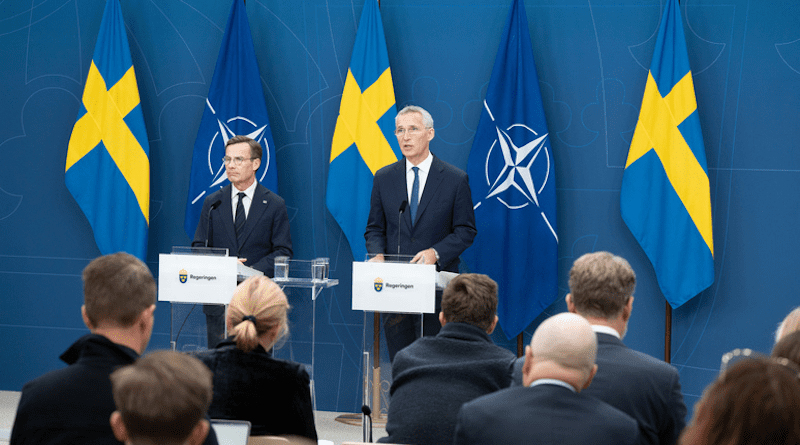Sweden Ready To Enter NATO, Clears Last Hungarian Hurdle
By EurActiv
By Charles Szumski
(EurActiv) — Hungary gave its green light on Monday (26 February) for Sweden to join NATO, thereby removing the final hurdle and paving the way for Sweden to become the military alliance’s 32nd full member.
After 20 months of delays and waiting, the Hungarian parliament, led by the Fidesz-KDNP majority of Hungarian Prime Minister Viktor Orbán voted in favour of Sweden’s accession to the transatlantic alliance with a large majority of 188 votes in favour and six against.
Sweden applied to join the Western military alliance in response to Russia’s attack on Ukraine just months after the invasion started, ending its long-standing tradition of non-military alignment.
Hungary’s interim President Lásló Kövér has now five days to sign the document, after which it will be flown to the United States and handed over to the State Department, the official depository of the accession protocols of all NATO members.
Once this is done, the following steps will be mainly bureaucratic with Sweden’s accession being announced by its Secretary-General Jens Stoltenberg, and a flag-raising ceremony will take place at NATO’s Headquarters in the north of Brussels, alongside its 31 military allies.
Sweden will then have to re-fit its military strategy and NATO its defence and deterrence plans to include the Baltic Sea and the Nordic country.
“Sweden’s membership will make us all stronger and safer,” Stoltenberg said, welcoming the news.
Hungarian Prime Minister Viktor Orbán echoed him, saying “Swedes joining NATO strengthens Hungary’s security”, while his Swedish counterpart rejoiced over the news.
“A historic day. All NATO countries’ parliaments have now voted in favour of Sweden’s NATO membership. We are ready to shoulder our share of the responsibility for NATO’s security,” wrote Swedish Prime Minister Ulf Kristersson on X, more than 20 months after applying for membership.
But the Hungarian yes vote was not a foregone conclusion.
Following the Russian invasion of Ukraine, Sweden and Finland applied in a joint bid for NATO membership in May 2022. Finland became the Alliance’s 31st member in April 2023, one year later.
Sweden, on the other hand, struggled for many months longer to gain the approval of NATO members Turkey and Hungary.
After Turkey ratified Sweden’s NATO bid in January, Hungary remained the only NATO member not to have given the green light to its accession, with the ruling Fidesz party repeatedly delaying a vote, citing grievances over Sweden’s criticism of Budapest‘s rule of law record.
The belated Hungarian vote comes after a major military agreement between Hungary and Sweden last Friday (23 February). The deal saw Hungary purchase four more Swedish-built JAS 39 Gripen aircraft and extend the current support and logistics contract by ten years from 2026 to 2036.
Since according to the contract, negotiations have been underway since 2021 and no specific hurdle has been reported, it remains unclear how the deal fitted into Sweden’s NATO membership bid.
Sweden’s NATO cost
As Sweden onboards into NATO, the financial burden it will bear remains a major question in Stockholm.
“Sweden’s direct contribution, which is used to finance NATO’s headquarters among other things would amount to SEK 600 million, which corresponds to approximately €54 million,” Per Olsson, defence economist at the Swedish Defence Research Agency (FOI) told Euractiv.
However, according to the expert, the indirect costs are more difficult to estimate, in particular the costs of reorganising certain sectors of the Swedish defence forces or replacing the personnel the country will have to send to the Alliance headquarters in Brussels.
Sweden is nevertheless already considered to be a good pupil, having already reached the 2% of GDP mark for defence spending expected from NATO countries.
“Last year, Sweden spent around €10 billion in defence, which corresponds to the NATO goals,” Olsson said, adding however that the country decided to boost investment in defence before applying to NATO, in response to the Russian invasion of Ukraine.
At the time, the Social Democratic Prime Minister Magdalena Andersson and her Defence Minister Peter Hulqvist advocated reaching the 2% GDP mark even though public opinion was not yet majoritarian in favour of joining NATO.
Sweden’s entry into NATO is also facilitated by the high level of military-technological compatibility between the countries of the transatlantic alliance and Sweden.
“Since the Swedish defence industry wants to sell weapons to other NATO countries, Sweden has used a lot of NATO standards and has a high degree of interoperability with NATO countries’ technologies,” Olsson said, citing as examples the European Meteor missiles that equip the Swedish Gripen fighter jets and the compatible artillery shell calibre.
“It should not be too dramatic a change for the Swedish economy,” Olsson concluded.

